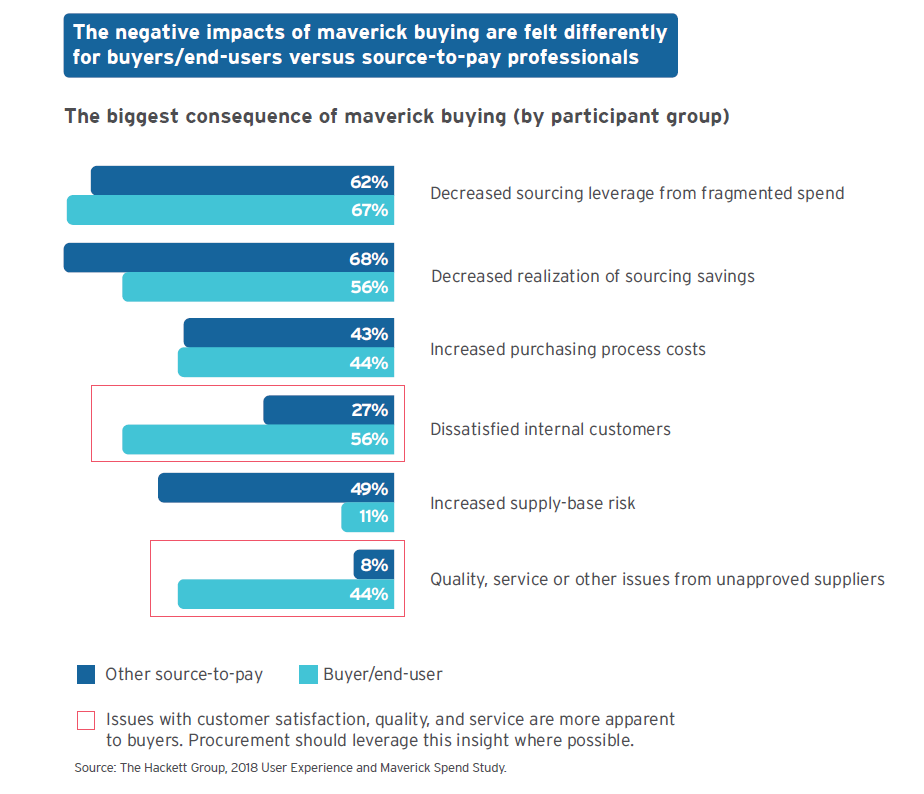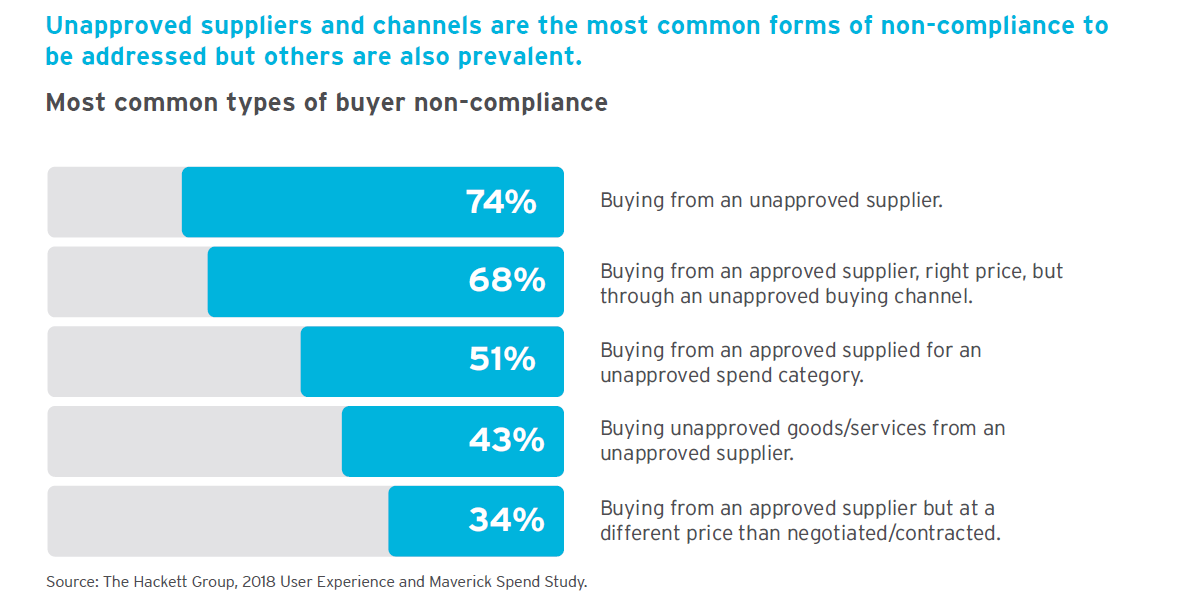- Blog
- Limiting Purchasing: Designing an Intuitive Buyer Experience
Limiting Purchasing: Designing an Intuitive Buyer Experience
According to a study we conducted with The Hackett Group, the most common types of buyer noncompliance that need to be addressed are buying from unapproved suppliers (74%) and through unapproved channels (68%).
You’ve likely seen it happen many times before. Someone at your company decides that they want to buy a product that doesn’t quite fit with your company’s procurement protocols and yet they still purchase it without blinking an eye. Perhaps they’ve found what they think is a better deal, perhaps they know someone at the company they’re purchasing from, or perhaps they just aren’t thinking through the consequences.


In addition, when it comes to buyers, two of the most common negative consequences of maverick buying are issues with satisfaction (56%), quality, and service (44%). Taken together, these consequences result in more returns, less use per purchase, and decreased efficiency.

To avoid these consequences, organisations need to address categories where users have difficulty finding what they want. To start, they need to understand that capital equipment and most service-related categories — including sales and marketing, general admin, HR — provide the least intuitive buying experiences, where only 40% rated the experience as being easy.
In light of this, it’s worth noting that lack of self-service and guided buying tools is the number one purchasing challenge facing end-users, with 75% of those surveyed saying this is a problem.
To overcome these problems, companies must develop four essential guided buying capabilities:
1. Self-Managed Buying
The ability to capture 100% of direct and indirect spend together with ongoing developments in machine learning and artificial intelligence have paved the way for compelling advancements in procurement capabilities. In practice, this means that buyers and sellers alike can get real-time guidance in making important procurement decisions every step of the way.
Above all, these advancements automate the procurement process so that employees don’t get bogged down with menial and mind-numbing tasks, freeing them up for more creative or strategic work. For instance, predefined buying channels can put compliant buying options at the fingertips of the requisitioner. This shift in the procurement process is certainly the way of the future.
2. Easy-To-Use Tools
As mentioned in the last point, no one wants to spend all their time worrying about compliance, much less navigating a complicated procurement system. To make the most of your team, you’ll want tools that are intuitive, streamlined, and easy to use.
For example, you might create a single point of entry to initiate self-managed requisitioning so your process doesn’t become overly complex as time goes on. You might also streamline and automate buying with a standard shopping cart experience so you can train the company on the single process and be done with it. Finally, you might offer support in the decision process using tools like chatbots, which can make the experience as simple as interacting with Siri or Alexa.
3. Buying from The Right Supplier
Of course, the simplest and most intuitive experience won’t help much if employees consistently buy products from unapproved suppliers. To fix this problem, start by creating category-based strategies and ensure for each category you have preferred suppliers selected and that there’s high-quality content available from these suppliers so that all end users are easily able to find what they are looking for. From there you can automate selection of the right supplier so the experience of purchasing from the right supplier becomes so simple that no one wants to do anything different. After that, you can enable compliant buying and negotiated savings realisation to solidify the process even further.
Taken together, these process improvements can be just the thing needed to change your culture from purchasing products from whatever supplier each employee personally likes best to buying from approved sources. In some cases, that’s the single most pivotal step toward being a company where compliance is the expectation and the norm.
4. Help When You Need It
When employees have a question about compliance, where can they turn? If the process is too difficult, they might give up and quit. So, if you want full compliance, it’s imperative to think about how employees might feel in moments of frustration and give them an easy way out.
To do this, implement an easy link to professional buyers via a company “buying desk,” so employees can immediately get the answers they’re seeking. That said, it might also be worth noting that employing a full support team can get expensive. So be sure to complement the human element with automated assistance based on system-managed buying rules and automated compliance triggers to help make the right buying decision. By pairing humans with machines, you’ll keep support costs down and provide the help people need right when they need it.
These four solutions — self-managed buying, easy-to-use tools, buying from the right supplier, and giving help right when people need it — will get you on the right foot so you can develop an intuitive buyer experience and become a leader in procurement and compliance.
Related
-
By Basware RepresentativeThe route to logistics software harmony for finance, AP and procurement
-
By Katarzyna FonteynA Reflection on the State of Procurement
-
By Katarzyna FonteynHow to create procurement visibility from day 1
-
By Basware RepresentativeDon’t Delay Digital Procurement & Finance Investments
-
By Ann StrömbergNordic Leaders Circle focused on procurement development
-
By Katie ColbourneProcure-to-Pay Trends Predictions and Advancements for 2022 and Beyond
-
By Basware RepresentativeBasware to Help Expand e-Invoicing with the Business Payment Coalition
-
By Ann StrömbergProcurement Collaboration, Resilience, Technology, and Sustainability

